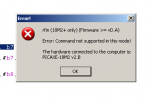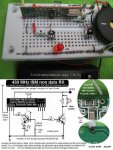NoEinstein
Member
I'm new to the PicAxe and I've never worked with any RF communications before so I was hoping somebody here might have some tips about using Sparkfun's 434MHz RF modules or something similar to them:
www.sparkfun.com/products/10534
www.sparkfun.com/products/10532
EDIT: NOTE: Please see post #59 of this thread for the solution to my problem with these Sparkfun units
I've been using a 14M2 PicAxe on both the transmitting and receiving ends using rfin and rfout and, of course, it doesn't work right away, so I'm now in the process of debugging my set-up. But while I do that, I was hoping somebody here might have some tips or tricks on what to beware of.
One question: the Sparkfun forums suggest that the transmitter needs to be running all the time for the receiver to lock onto it, but I also get the impression the Manchester encoding would eliminate that requirement. True?
Also, just to be sure I'm doing this right, would the following line of code work for the transmitter?
And for the receiver on a different PicAxe?
Thanks
www.sparkfun.com/products/10534
www.sparkfun.com/products/10532
EDIT: NOTE: Please see post #59 of this thread for the solution to my problem with these Sparkfun units
I've been using a 14M2 PicAxe on both the transmitting and receiving ends using rfin and rfout and, of course, it doesn't work right away, so I'm now in the process of debugging my set-up. But while I do that, I was hoping somebody here might have some tips or tricks on what to beware of.
One question: the Sparkfun forums suggest that the transmitter needs to be running all the time for the receiver to lock onto it, but I also get the impression the Manchester encoding would eliminate that requirement. True?
Also, just to be sure I'm doing this right, would the following line of code work for the transmitter?
Code:
RFout B.1, ("Success!")
Code:
RFin C.0, b0, b1, b2, b3, b4, b5, b6, b7
Last edited:





